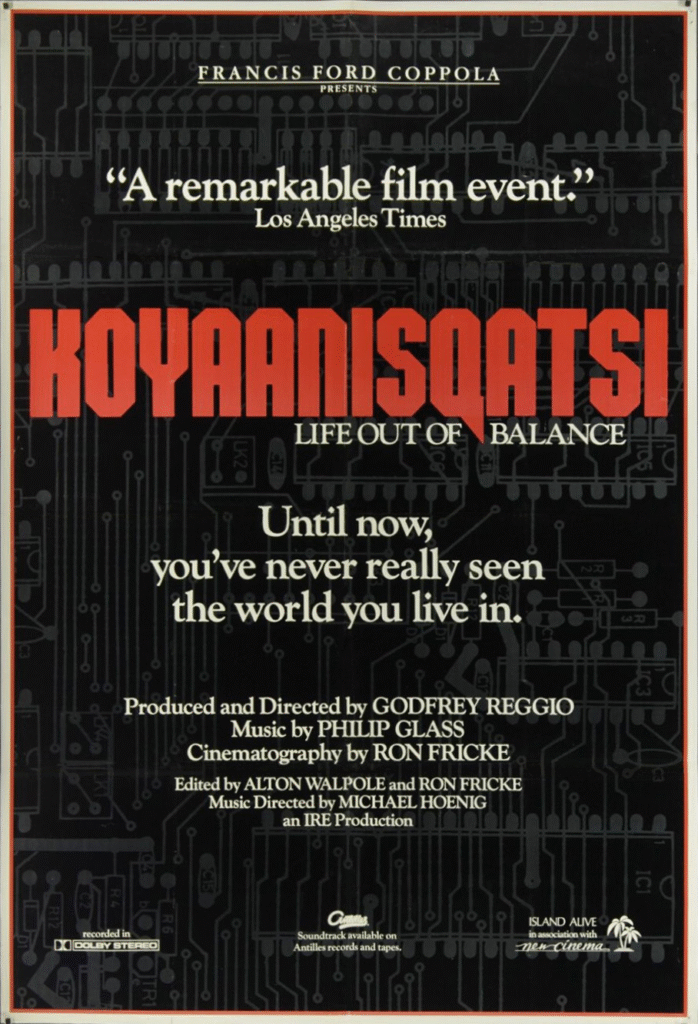
One author actually wrote about the movie: “It feels strange to be discussing Koyaanisqatsi using words since the film communicates its message purely with images and sound, utilizing no spoken dialogue at all.”
‘Koyaanisquatsi’ is a Hopi Indian word which implies ‘life in turmoil’ or ‘life out of balance’. This film, directed by Godfrey Reggio, consists of a serious of beautifully shot scenes, played to the recurring and haunting sound of music provided by Philip Glass. Koyaanisqatsi is a documentary, albeit only arguably so. It is constructed purely on the passage of time. It is also a visual concert of images set to a haunting music. There is no dialogue in the film, there are no characters in the film, there is no story; if there is something, it is a simple idea to portray and draw a comparison between forces of nature and man’s efforts at technological supremacy.
The film was a landmark for a few reasons. Firstly, it was the first film, feature length, to have used “time lapse photography” at such a large scale. Time lapse photography is a technique where the on-screen event is either sped up or slowed down, to get a desired cinematic effect. Traditionally, the technique has been such: if you want to speed up a scene (say clouds moving slowly in the sky), you would shoot at (for example) 1 fps (frames per second) for a few hours, and then project it at the standard 24 fps. And if you wanted to slow down a scene, then you shot it at fps higher than 24. In fact, although the idea had been put into practice many times before, the film was the first to use it at an epic scale. It is also said, (quite politically incorrectly) that this was the film that gave birth to the concept of something we today know as the “Discovery Channel”. How many times, have we seen on television, the sight of a full sunrise sped up to last only a few seconds? Or rows and rows of people commuting on sidewalks, the scene sped up? Well, this film, unofficially, started it.
Secondly, the film’s idea was novel. A visual composition based purely on sound (Philip Glass’s score is just spine-chilling at times), making use of nothing but the beauty of music and cinematography (personally the most awe-inspiring cinematography I have ever seen), it weaves a story. The story of nature. And man. And man’s struggle against nature.
I read somewhere(so do not quote me on this), that Reggio was intent on Philip Glass producing the score. He approached Glass through a mutual friend, and Glass replied, “I don’t do film music.” Reggio persisted, until he gained a meeting with Glass who nevertheless declined. Determined, Reggio put together a photo montage with Glass’ music as the soundtrack, which he presented to Glass at a private screening in New York. Immediately following this, Glass agreed to score the film.
At the beginning of the film, the camera lingers on ancient Hopi Indian cave-paintings of human figures, which become symbolic of a lost wisdom, that perhaps the human race once had. Soon we are racing over landscapes, peering into waterfalls and tumbling with the clouds in a homage to the Earth. Effortlessly illustrating the vistas untainted by Man the film subtly moves on to the modern-day shrines to humanity – cities. It is here that the full impact of the story becomes apparent and yet there is a distance from people as individuals. Even when we are focused on one person, there is no feeling for their history, instead they appear as representatives for the whole. The city is shown to be a symbiotic life form, and as such, on a larger scale the teeming freeways become analogous to the blood vessels of our own bodies. But, this is no paradise. Humans, like trained primates, are shown to be in the rat-race like never before with no hope of redemption. Apocalyptic images of massive buildings crumbling to the ground, coupled with shots of volcanic eruptions, do spell out a doom that humans are destined to, unless, perhaps, we return to the ways of the ancient races.
The film is truly hypnotic. There is no editing involved. The whole film seems to be constructed around a beautiful score, and the music adds life to the already visually brilliant shots. It is no co-incidence, then, that the film took nine (yes 9!)whole years to be completed. Some of the shots seem so difficult, and just so magical, that it is hard, for a layperson, to believe taking such a shot is at all possible, let alone figuring out exactly how it was done. My personal favorite is a sequence that shows the close-up (sped-up photography) of clouds blowing across the sky. One becomes immersed in the white, snowy tufts. The viewer is flying with the clouds…And then the camera zooms out. And one realizes, that is a wave in the gigantic ocean. Then after a few more seconds, the viewer notices, that there is a diegetic juxtaposition of sped-up cloud shots, and slowed-down ocean wave shots. One cannot help, but remain in awe of the vision that one just saw.
The film won the “Francis Ford Coppola Presents” endorsement at the 1982 New York Film Festival, and Coppola is now credited as an executive producer of the film. In an interview, Godfrey Reggio said “…[Coppola] would like to do everything possible to make this available to the public, so he put his name on it”.
The film is a truly majestic exploration of the highest beauty known to man- Nature.
